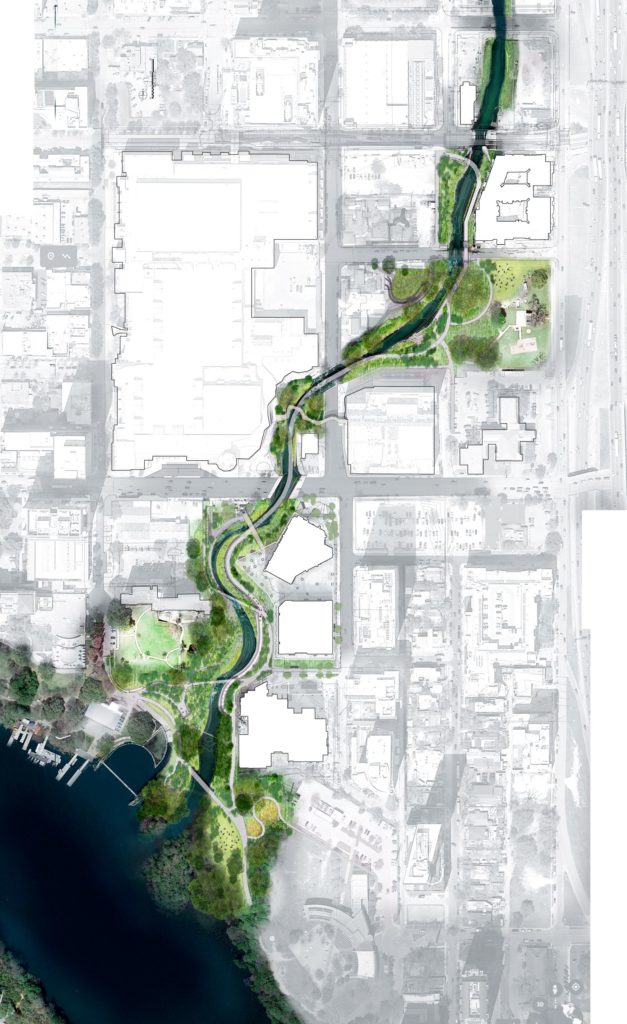About the Author
Chad Swiatecki is a 20-year journalist who relocated to Austin from his home state of Michigan in 2008. He most enjoys covering the intersection of arts, business and local/state politics. He has written for Rolling Stone, Spin, New York Daily News, Texas Monthly, Austin American-Statesman and many other regional and national outlets.
Newsletter Signup
The Austin Monitor thanks its sponsors. Become one.
Most Popular Stories
- Latest State of Downtown report shows the city core’s businesses and housing are in transition
- Cap Metro to shelve 46 new electric buses for a year after manufacturer bankruptcy
- Jesús Garza disputes allegation that he violated city ethics rule
- Mobility Committee hears public concern regarding expansion of MoPac
- Council gives first reading OK to major development on tiny slice of land
-
Discover News By District

Photo by Waterloo Greenway
Waterloo Greenway gets $9M federal grant for second phase of parks system
Tuesday, April 26, 2022 by Chad Swiatecki
The parks system that is expected to rehabilitate Waller Creek and create a series of parks through downtown Austin has received a $9 million federal grant to reconstruct and enhance a portion of parkland between Lady Bird Lake and Fourth Street.
The grant comes from the U.S. Army Corps of Engineers with funding from the Biden administration’s Infrastructure Investment and Jobs Act. It represents a part of the $80 million total cost of restoring the creek that has deteriorated due to repeated flooding. The section, which will be known as the Confluence, is the second phase of the Waterloo Greenway system, a $260 million effort to create a series of parks from 15th Street to the lake.
In addition to the reconstruction, which will go through the city’s bidding process with an expected start in October, Army Corps engineers will work to bring 1,550 trees, 200,000 mature plants and 10 acres of seed mixes to the Confluence area.
Jesús Aguirre, CEO of Waterloo Greenway, said the federal dollars are a welcome addition to the fundraising efforts of the conservancy for the park system that is halfway toward its $100 million goal. Another $110 million is being contributed via the city from a tax increment financing program that channels property taxes raised from the increase in property values throughout the Waller Creek District made possible by the flood mitigation capacity of the Waller Creek tunnel.
“From a pragmatic standpoint we need money to complete the project, and when you see everything that’s going on with development prices you know that bringing in this kind of money is absolutely critical,” Aguirre said. “The infusion of federal dollars like this is symbolic and transformational and it will help us bring the project to fruition. While we’re working with the conservancy and the city, the only way we are going to be able to see this through is by securing these kinds of federal dollars.”
U.S. Rep. Lloyd Doggett praised the environmental focus of the grant, while noting that most of the $30 billion coming to Texas through the infrastructure legislation will go toward state transportation efforts, including the Project Connect mass transit plan.
“Waterloo is most likely the only project our area will receive through the Corps of Engineers, though we may be able to secure some additional funding for it beyond the $9 million,” he said via email. “This project is notable as the first environmental infrastructure project federally funded in the state of Texas, made possible only because of the Infrastructure Investment and Jobs Act. This law also funds a significant increase in the number of electric vehicle charging stations here and across Texas.”
Aguirre said the next major phase of Waterloo Greenway will be focused around Palm Park, with planning and design expected to begin this fall. While City Council has already approved the overall vision for the parks system, relevant boards and commissions as well as the current Council will receive updates on progress in the coming months. Some of those updates will likely include revisions that may be necessary because of escalating construction and real estate costs that are increasing the price tag for major public works projects such as Project Connect.
Aguirre added that with a project of this scope, some modifications are almost always needed when going from a conceptual design to construction. But, he noted, “We’ve worked very closely with our designers and city partners to make sure we honor the basic tenets of this project.”
The Austin Monitor’s work is made possible by donations from the community. Though our reporting covers donors from time to time, we are careful to keep business and editorial efforts separate while maintaining transparency. A complete list of donors is available here, and our code of ethics is explained here.
Posted In: Parks, District 9
You're a community leader
And we’re honored you look to us for serious, in-depth news. You know a strong community needs local and dedicated watchdog reporting. We’re here for you and that won’t change. Now will you take the powerful next step and support our nonprofit news organization?









